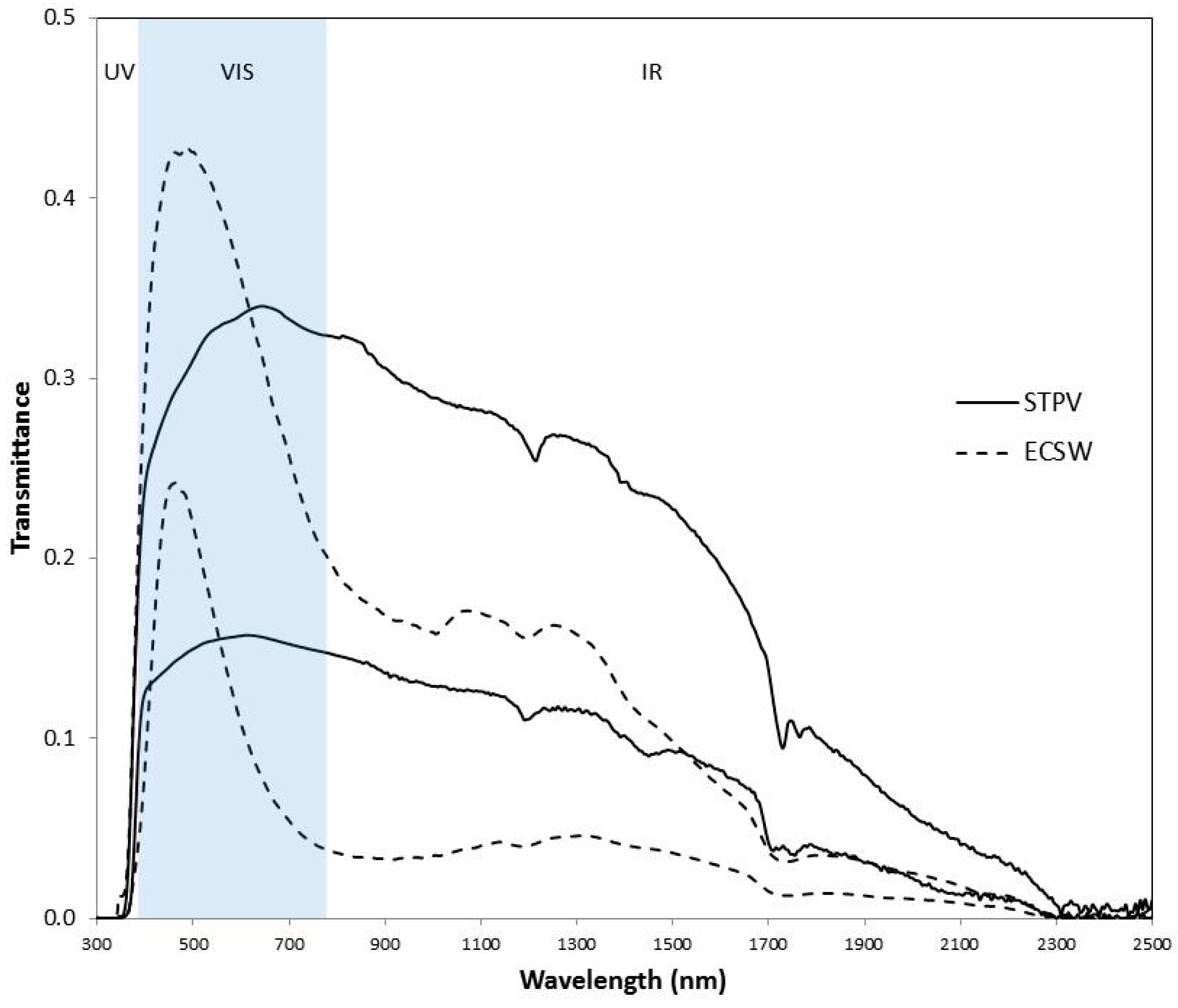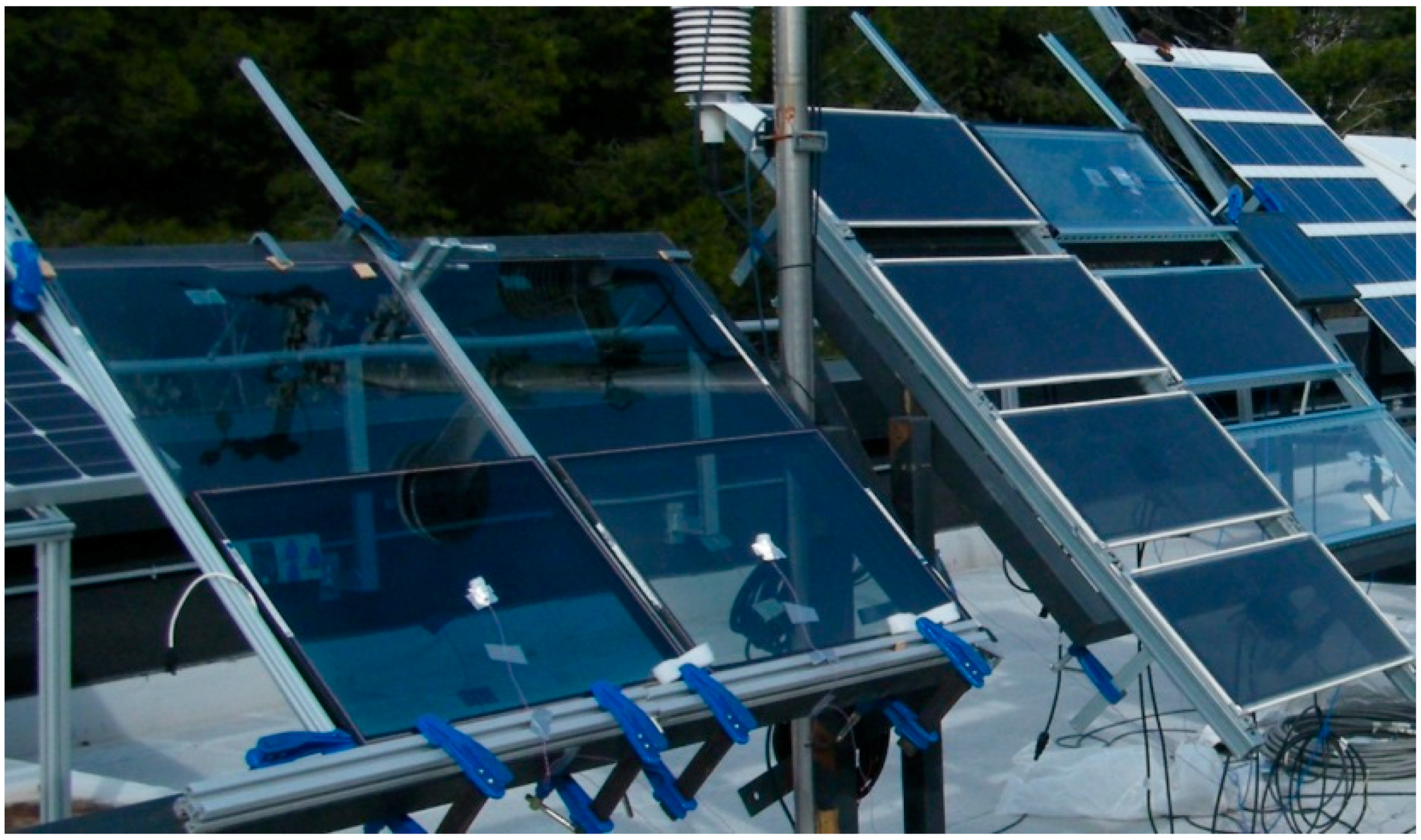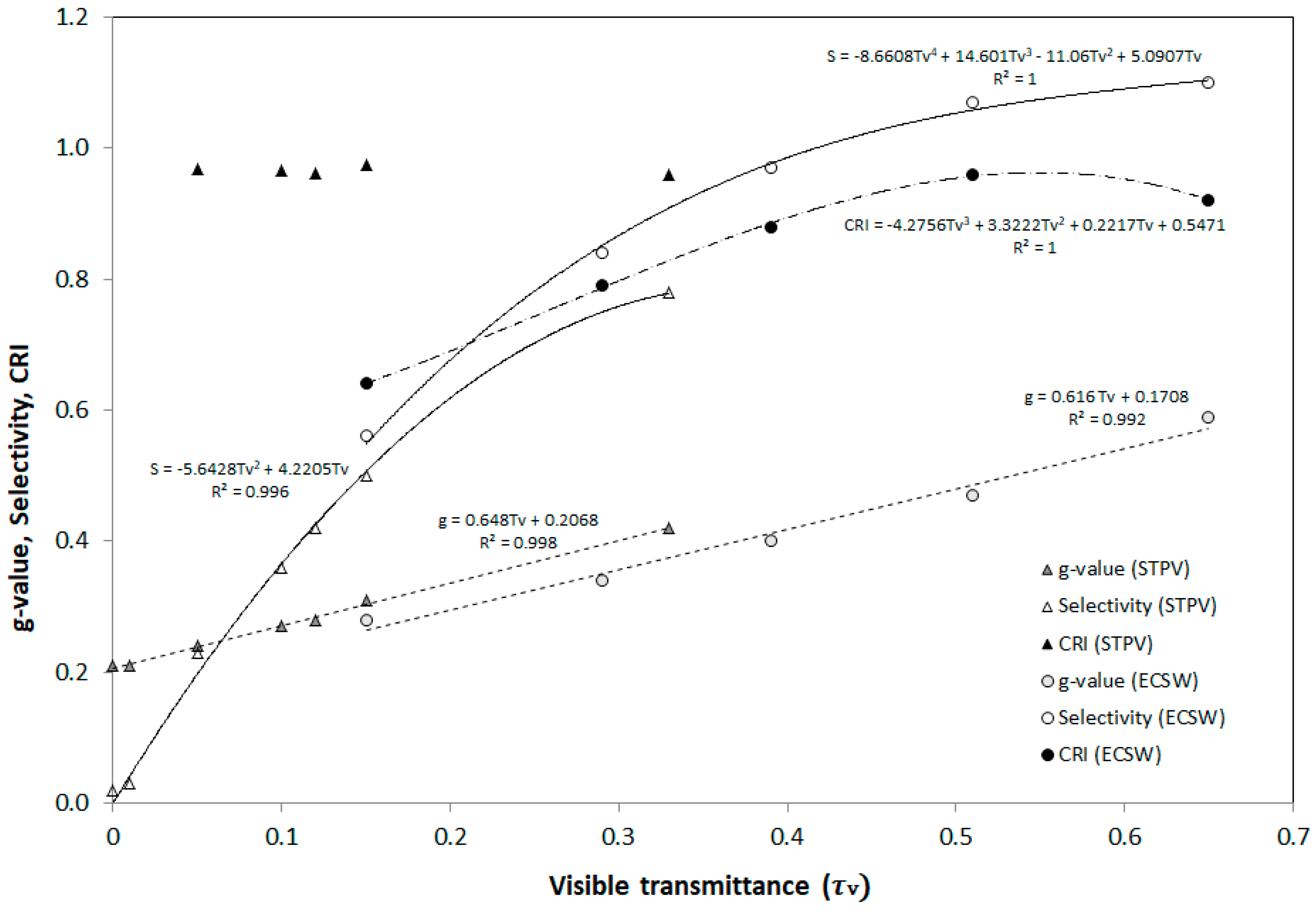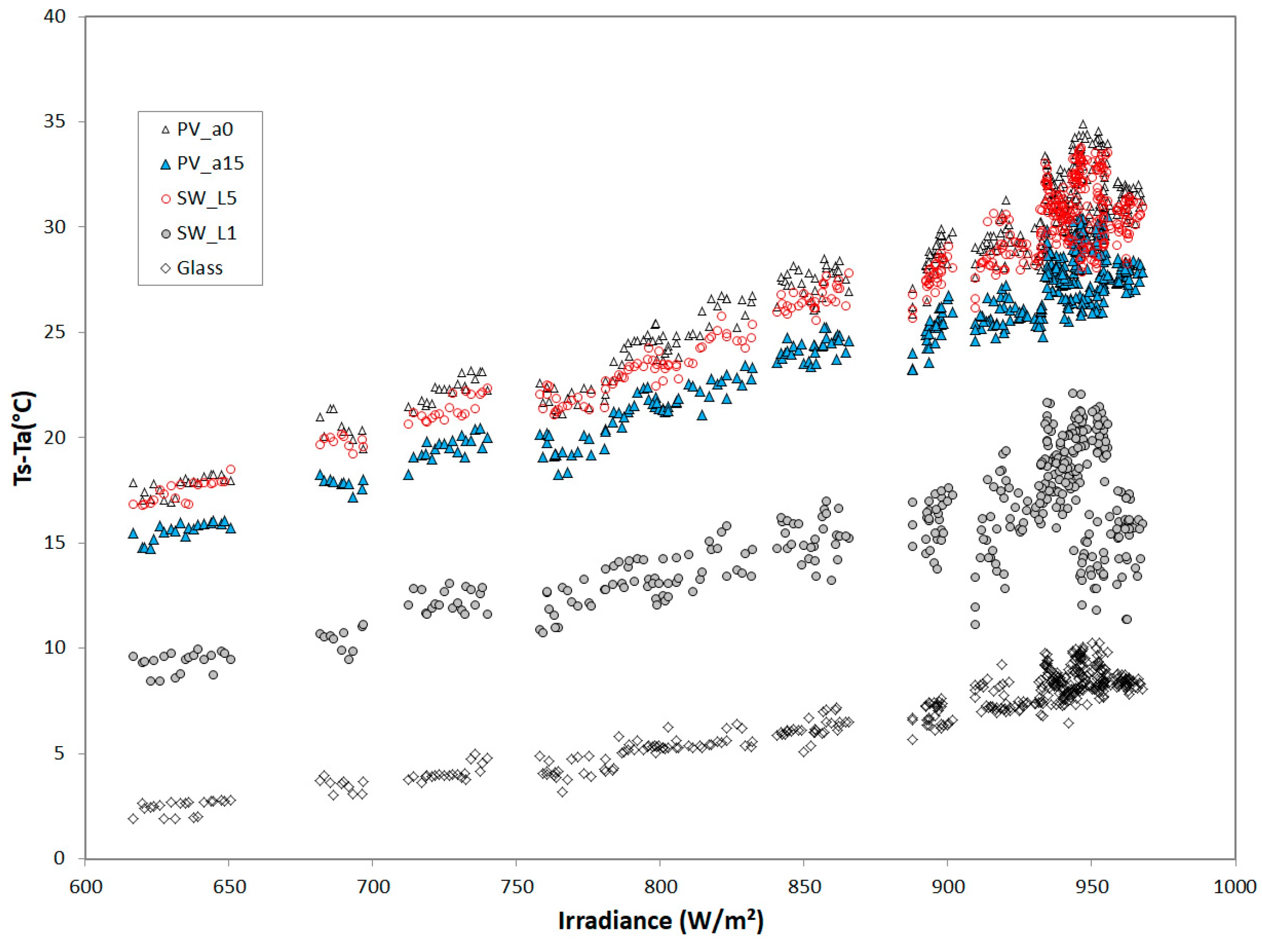Comparative Performance of Semi-Transparent PV Modules and Electrochromic Windows for Improving Energy Efficiency in Buildings
Abstract
1. Introduction
2. Approach
- PV laminate (7.16 mm): 3.2 mm float glass + a-Si thin film solar cells + 0.76 PVB/EVA foils + 3.2 mm float glass. These samples are identified as “PV_a#”, if the encapsulant is EVA, and “PV_b#”, if the encapsulant is PVB, being # the light transmittance in percentage.
- PV double glazing (27.16 mm): 3.2 mm float glass + a-Si thin film solar cells + 0.76 mm PVB/EVA foils + 3.2 mm float glass + 16 mm space between panes + 4 mm float glass. These samples are identified as “PV_a# (dg-16)” or “PV-b# (dg-16)”.
- EC laminate (9 mm): 4 mm float glass + 1 mm electrochromic device (thin-film electrodes and electrochromic materials between them) + 4 mm float glass. These samples are identified as “SW_L#”, where # refers to the state of the electrochromic device.
- EC double glazing (29 mm): 9 mm electrochromic laminated glass + 16 mm space between the panes + 4 mm inside float glass pane with heat protection coating. These samples are identified as “SW_L# (dg-16)”.
3. Results and Discussion
3.1. Lighting and Solar Performance
- Visible light transmittance and reflectance (τv, ρv), which represent the fraction of the incident light coming from a D65 daylight standard illuminant that is transmitted or reflected by the glazing and viewed by a standard photopic observer assumed as reference.
- Solar direct transmittance and reflectance (τe, ρe), which represent the fraction of the incident solar radiation (from 300 to 2500 nm) that is transmitted or reflected by the glazing, weighted by the standard solar spectral irradiance S(λ).
- Solar factor (or g-value), which represents the total solar energy transmitted indoors through the glazing, both by direct transmission and by indoor emission of part of the absorbed energy:where αe is the solar direct absorptance, calculated as αe = 1 − τe − ρe, and hi and he are the internal and external heat transfer coefficients, respectively, being hi = 7.7 W/m2 K and he = 25.0 W/m2 K the standard values according to EN 673. Shading coefficient (SC), which compares the g-value of the tested sample with that of a standard 3–4 mm thick float glass, SC = g/0.87.
- Selectivity index (S), which compares the light transmittance with the solar factor (S = τv/g). High selectivity index indicates good solar control and high light transmission.
- Color rendering index (CRI), which indicates the accuracy in the colors reproduction through the glazing. It is considered good color rendering if 0.60 ≤ CRI ≤ 0.79 and excellent if CRI ≥ 0.80.
3.2. Indoors Thermal Testing
3.3. Outdoors Thermal Testing
4. Conclusions
Author Contributions
Funding
Conflicts of Interest
References
- Pérez-Lombard, L.; Ortiz, J.; Pout, C. A review on buildings energy consumption information. Energy Build. 2008, 40, 394–398. [Google Scholar] [CrossRef]
- Krarti, M.; Dubey, K. Benefits of energy efficiency programs for residential buildings in Bahrain. J. Build. Eng. 2018, 18, 40–50. [Google Scholar] [CrossRef]
- Amirkhani, M.; Garcia-Hansen, V.; Isoardi, G.; Allan, A. An energy efficient lighting design strategy to enhance visual comfort in offices with windows. Energies 2017, 10, 1126. [Google Scholar] [CrossRef]
- Salvadori, G.; Fantozzi, F.; Rocca, M.; Leccese, F. The energy audit activity focused on the lighting systems in historical buildings. Energies 2016, 9. [Google Scholar] [CrossRef]
- Valancius, R.; Jurelionis, A.; Dorosevas, V. Method for cost-benefit analysis of improved indoor climate conditions and reduced energy consumption in office buildings. Energies 2013, 6, 4591–4606. [Google Scholar] [CrossRef]
- EU Directive 2010/31/EU of the European Parliament and of the Council of 19 May 2010 on the energy performance of buildings. Off. J. Eur. Union 2010, L153, 13–35.
- EU Directive 2012/27/EU of the European Parliament and of the Council of 25 October 2012 on energy efficiency. Off. J. Eur. Union 2012, L315, 1–56.
- Rezaei, S.D.; Shannigrahi, S.; Ramakrishna, S. A review of conventional, advanced, and smart glazing technologies and materials for improving indoor environment. Sol. Energy Mater. Sol. Cells 2017, 159, 26–51. [Google Scholar] [CrossRef]
- Fernandes, L.L.; Lee, E.S.; Ward, G. Lighting energy savings potential of split-pane electrochromic windows controlled for daylighting with visual comfort. Energy Build. 2013, 61, 8–20. [Google Scholar] [CrossRef]
- Dussault, J.M.; Gosselin, L. Office buildings with electrochromic windows: A sensitivity analysis of design parameters on energy performance, and thermal and visual comfort. Energy Build. 2017, 153, 50–62. [Google Scholar] [CrossRef]
- Chae, Y.T.; Kim, J.; Park, H.; Shin, B. Building energy performance evaluation of building integrated photovoltaic (BIPV) window with semi-transparent solar cells. Appl. Energy 2014, 129, 217–227. [Google Scholar] [CrossRef]
- Olivieri, L.; Caamaño-Martín, E.; Moralejo-Vázquez, F.J.; Martín-Chivelet, N.; Olivieri, F.; Neila-Gonzalez, F.J. Energy saving potential of semi-transparent photovoltaic elements for building integration. Energy 2014, 76, 572–583. [Google Scholar] [CrossRef]
- Moralejo-Vázquez, F.J.; Martín-Chivelet, N.; Olivieri, L.; Caamaño-Martín, E. Luminous and solar characterization of PV modules for building integration. Energy Build. 2015, 103, 326–337. [Google Scholar] [CrossRef]
- Leite Didoné, E.; Wagner, A. Semi-transparent PV windows: A study for office buildings in Brazil. Energy Build. 2013, 67, 136–142. [Google Scholar] [CrossRef]
- Wang, M.; Peng, J.; Li, N.; Lu, L.; Ma, T.; Yang, H. Assessment of energy performance of semi-transparent PV insulating glass units using a validated simulation model. Energy 2016. [Google Scholar] [CrossRef]
- DeForest, N.; Shehabi, A.; Selkowitz, S.; Milliron, D.J. A comparative energy analysis of three electrochromic glazing technologies in commercial and residential buildings. Appl. Energy 2017, 192, 95–109. [Google Scholar] [CrossRef]
- Tavares, P.; Bernardo, H.; Gaspar, A.; Martins, A. Control criteria of electrochromic glasses for energy savings in mediterranean buildings refurbishment. Sol. Energy 2016, 134, 236–250. [Google Scholar] [CrossRef]
- Dussault, J.M.; Sourbron, M.; Gosselin, L. Reduced energy consumption and enhanced comfort with smart windows: Comparison between quasi-optimal, predictive and rule-based control strategies. Energy Build. 2016, 127, 680–691. [Google Scholar] [CrossRef]
- Windows & Daylighting. Available online: https://windows.lbl.gov/software/window (accessed on 15 March 2018).
- Energy Plus. Available online: https://energyplus.net/ (accessed on 16 February 2018).
- Asdrubali, F.; Baldinelli, G. Thermal transmittance measurements with the hot box method: Calibration, experimental procedures, and uncertainty analyses of three different approaches. Energy Build. 2011, 43, 1618–1626. [Google Scholar] [CrossRef]
- Chen, F.; Wittkopf, S.K.; Khai Ng, P.; Du, H. Solar heat gain coefficient measurement of semi-transparent photovoltaic modules with indoor calorimetric hot box and solar simulator. Energy Build. 2012, 53, 74–84. [Google Scholar] [CrossRef]
- Gueymard, C.A.; duPont, W.C. Spectral effects on the transmittance, solar heat gain, and performance rating of glazing systems. Sol. Energy 2009, 83, 940–953. [Google Scholar] [CrossRef]
- Mazzali, U.; Ruggeri, P.; Zinzi, M.; Peron, F.; Romagnoni, P.; Daneo, A. Set-up and calibration by experimental data of a numerical model for the estimation of solar factor and Ug-value of building integrated photovoltaic systems. Energy Procedia 2015, 78, 2202–2207. [Google Scholar] [CrossRef]
- CENELEC EN 674:2011. Glass in Building. Determination of Thermal Transmittance (U Value)—Guarded Hot Plate Method; British Standards Institution: London, UK, 2011. [Google Scholar]
- CENELEC EN 673:2011. Glass in Building. Determination of Thermal Transmittance (U Value)—Calculation Method; British Standards Institution: London, UK, 2011. [Google Scholar]
- CENELEC EN 50583-1:2016. Photovoltaics in Buildings—Part 1: BIPV Modules; British Standards Institution: London, UK, 2016. [Google Scholar]
- CENELEC EN 410:2011. Glass in Building. Determination of Luminous and Solar Characteristics of Glazing; British Standards Institution: London, UK, 2011. [Google Scholar]
- CIE 13.3:1995 International Commission on Illumination. Method of Measuring and Specifying Colour Rendering Properties of Light Sources; International Commission on Illumination: Vienna, Austria, 1995. [Google Scholar]
- IEC 61646:2008. Thin-Film Terrestrial Photovoltaic (PV) Modules—Design Qualification and Type Approval; International Electrotechnical Commission (IEC): Geneva, Switzerland, 2008. [Google Scholar]
- Piccolo, A.; Simone, F. Performance requirements for electrochromic smart window. J. Build. Eng. 2015, 3, 94–103. [Google Scholar] [CrossRef]
- Assimakopoulos, M.N.; Tsangrassoulis, A.; Guarracino, G.; Santamouris, M. Integrated energetic approach for a controlable electrochromic device. Energy Build. 2004, 36, 415–422. [Google Scholar] [CrossRef]
- Jonsson, A.; Roos, A. Evaluation of control strategies for different smart window combinations using computer simulations. Sol. Energy 2010, 84, 1–9. [Google Scholar] [CrossRef]
- Sibilio, S.; Rosato, A.; Scorpio, M.; Iuliano, G.; Ciampi, G.; Vanoli, G.; de Rossi, F. A Review of Electrochromic Windows for Residential Applications. Int. J. Heat Technol. 2016, 34, S481–S488. [Google Scholar] [CrossRef]
- Sanders, H.; Podbelski, L. Dynamic façades: Solving the High Performance Building Challenge without Design Compromise. In Proceedings of the BEST4 Conference, Kansas City, MO, USA, 13–15 April 2015. [Google Scholar]
- Hermelink, A.; von Manteuffel, B.; Grözinger, J. Minimum Performance Requirements for Window Replacement in the Residential Sector; Ecofys: Berlin, Germany, 2017. [Google Scholar]
- Alamri, S.N. The temperature behavior of smart windows under direct solar radiation. Sol. Energy Mater. Sol. Cells 2009, 93, 1657–1662. [Google Scholar] [CrossRef]
- Piccolo, A. Thermal performance of an electrochromic smart window tested in an environmental test cell. Energy Build. 2010, 42, 1409–1417. [Google Scholar] [CrossRef]
- Baker, P.H.; van Dijk, H.A.L. PASLINK and dynamic outdoor testing of building components. Build. Environ. 2008, 43, 143–151. [Google Scholar] [CrossRef]




| Device Structure (Single Glazing) | Transmittance | Name |
| glass (3.2 mm)/aSi/EVA (0.76 mm)/Glass (3.2 mm) | 0% | PV_a0 |
| 5% | PV_a5 | |
| 10% | PV_a10 | |
| 15% | PV_a15 | |
| glass (3.2 mm)/aSi/PVB (0.76 mm)/glass (3.2 mm) | 0% | PV_b0 |
| 12% | PV_b12 | |
| 33% | PV_b33 | |
| glass (4 mm)/EC (1 mm)/glass (4 mm) | Level 1 | SW_L1 |
| Level 2 | SW_L2 | |
| Level 3 | SW_L3 | |
| Level 4 | SW_L4 | |
| Level 5 | SW_L5 | |
| Device Structure (Double Glazing) | Transmittance | Name |
| glass (3.2 mm)/aSi/EVA (0.76 mm)/glass (3.2 mm)/spacer (16 mm)/glass (4 mm) | 0% | PV_a0(dg_16) |
| glass (3.2 mm)/aSi/PVB (0.76 mm)/glass (3.2 mm)/spacer (16 mm)/glass (4 mm) | 0% | PV_b0(dg_16) |
| 30% | PV_b30(dg_16) | |
| glass (4 mm)/EC (1 mm)/glass (4 mm)/spacer (16 mm)/glass (4 mm) | Level 1 | SW_L1(dg_16) |
| Level 5 | SW_L5(dg_16) | |
| glass (4 mm)/spacer (16 mm)/glass (4 mm) | FG(dg_16) | |
| glass (4 mm)/spacer (24 mm)/glass (4 mm) | FG(dg_24) |
| PV_a0 | PV_a5 | PV_a10 | PV_a15 | PV_b0 | PV_b12 | PV_b33 | SW_L1 | SW_L2 | SW_L3 | SW_L4 | SW_L5 | |
|---|---|---|---|---|---|---|---|---|---|---|---|---|
| τv | 0.00 | 0.05 | 0.10 | 0.15 | 0.01 | 0.12 | 0.33 | 0.65 | 0.51 | 0.39 | 0.29 | 0.15 |
| ρv | 0.07 | 0.08 | 0.07 | 0.07 | 0.08 | 0.07 | 0.08 | 0.11 | 0.09 | 0.08 | 0.08 | 0.08 |
| τe | 0.00 | 0.05 | 0.08 | 0.13 | 0.00 | 0.10 | 0.28 | 0.51 | 0.35 | 0.25 | 0.18 | 0.09 |
| ρe | 0.12 | 0.13 | 0.12 | 0.12 | 0.14 | 0.12 | 0.11 | 0.13 | 0.12 | 0.11 | 0.11 | 0.11 |
| αe | 0.87 | 0.82 | 0.80 | 0.76 | 0.86 | 0.79 | 0.61 | 0.36 | 0.53 | 0.64 | 0.72 | 0.81 |
| g | 0.21 | 0.24 | 0.27 | 0.31 | 0.21 | 0.28 | 0.42 | 0.59 | 0.47 | 0.40 | 0.34 | 0.28 |
| SC | 0.24 | 0.28 | 0.31 | 0.35 | 0.24 | 0.33 | 0.48 | 0.68 | 0.54 | 0.46 | 0.40 | 0.32 |
| S | 0.02 | 0.23 | 0.36 | 0.50 | 0.03 | 0.42 | 0.78 | 1.10 | 1.07 | 0.97 | 0.84 | 0.56 |
| CRI | - | 0.97 | 0.97 | 0.97 | - | 0.96 | 0.96 | 0.92 | 0.96 | 0.88 | 0.79 | 0.64 |
| FG (dg_16) | FG (dg_24) | PV_a0 | PV_b0 (dg_16) | PV_b30 (dg_16) | SW_L1/SW_L5 | SW_L1/SW_L5 (dg_16) | |
|---|---|---|---|---|---|---|---|
| U-value (W/m2 K) | 2.8 | 2.9 | 5.1 | 2.8 | 2.8 | 5.0 | 1.4 |
| Std. Error (W/m2 K) | 0.2 | 0.2 | 0.2 | 0.4 | 0.4 | 0.2 | 0.2 |
| PV_a0 | PV_a15 | SW_L5 | SW_L1 | |
|---|---|---|---|---|
| TN (°C) | 45.8 | 42.8 | 45.2 | 34.4 |
| R2 | 0.85 | 0.85 | 0.84 | 0.54 |
| σ (°C) | 1.6 | 1.4 | 1.6 | 2.0 |
© 2018 by the authors. Licensee MDPI, Basel, Switzerland. This article is an open access article distributed under the terms and conditions of the Creative Commons Attribution (CC BY) license (http://creativecommons.org/licenses/by/4.0/).
Share and Cite
Martín-Chivelet, N.; Guillén, C.; Trigo, J.F.; Herrero, J.; Pérez, J.J.; Chenlo, F. Comparative Performance of Semi-Transparent PV Modules and Electrochromic Windows for Improving Energy Efficiency in Buildings. Energies 2018, 11, 1526. https://doi.org/10.3390/en11061526
Martín-Chivelet N, Guillén C, Trigo JF, Herrero J, Pérez JJ, Chenlo F. Comparative Performance of Semi-Transparent PV Modules and Electrochromic Windows for Improving Energy Efficiency in Buildings. Energies. 2018; 11(6):1526. https://doi.org/10.3390/en11061526
Chicago/Turabian StyleMartín-Chivelet, Nuria, Cecilia Guillén, Juan Francisco Trigo, José Herrero, Juan José Pérez, and Faustino Chenlo. 2018. "Comparative Performance of Semi-Transparent PV Modules and Electrochromic Windows for Improving Energy Efficiency in Buildings" Energies 11, no. 6: 1526. https://doi.org/10.3390/en11061526
APA StyleMartín-Chivelet, N., Guillén, C., Trigo, J. F., Herrero, J., Pérez, J. J., & Chenlo, F. (2018). Comparative Performance of Semi-Transparent PV Modules and Electrochromic Windows for Improving Energy Efficiency in Buildings. Energies, 11(6), 1526. https://doi.org/10.3390/en11061526





